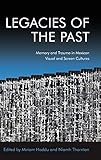Legacies of the Past : Memory and Trauma in Mexican Visual and Screen Cultures / Niamh Thornton, Miriam Haddu.
Material type: TextPublisher: Edinburgh : Edinburgh University Press, [2022]Copyright date: ©2020Description: 1 online resource (200 p.) : 16 B/W illustrationsContent type:
TextPublisher: Edinburgh : Edinburgh University Press, [2022]Copyright date: ©2020Description: 1 online resource (200 p.) : 16 B/W illustrationsContent type: - 9781474480536
- 9781474480550
- 791.4365872 23
- online - DeGruyter
| Item type | Current library | Call number | URL | Status | Notes | Barcode | |
|---|---|---|---|---|---|---|---|
 eBook
eBook
|
Biblioteca "Angelicum" Pont. Univ. S.Tommaso d'Aquino Nuvola online | online - DeGruyter (Browse shelf(Opens below)) | Online access | Not for loan (Accesso limitato) | Accesso per gli utenti autorizzati / Access for authorized users | (dgr)9781474480550 |
Frontmatter -- Contents -- List of Figures -- Notes on Contributors -- Acknowledgements -- Introduction: Legacies of the Past: Memory and Trauma in Mexican Visual and Screen Culture -- 1 On the Commemoration of Mexico ’68: Los agachados de Rius, número especial de los cocolazos de julio-agostoseptiembre y octubre quién sabe si tambor . . . -- 2 Felipe Cazals and Servando González Grapple with the Aftermath and the Archive: 1976 and 1968 -- 3 Spectres of Mexico’s ‘Dirty Wars’: Gendered Haunting and the Legacy of Women’s Armed Resistance in Mexican Documentary Film -- 4 Stages for an Assassination: Roles of Cinematic Landscape in Jorge Fons’ El atentado (2010) and Carlos Bolado’s Colosio: el asesinato (2012) -- 5 Aliens as Superheroes: Science Fiction, Immigration and Dulce Pinzón’s ‘The Real Story of the Superheroes’ -- 6 #YoSoy132 as a Continuation of the 1968 Legacy -- 7 Loss and Mourning in Documentary: Tatiana Huezo’s Ausencias (2015) -- 8 Teresa Margolles’ Work with Space: Ruins, Resonances and the Echo of the Absent -- Index
restricted access online access with authorization star
http://purl.org/coar/access_right/c_16ec
Examines how trauma haunts the spaces and places of Mexican film and visual cultureCase studies include Flor en Otomi, El Atentado, Los Poquianchis and AusenciasCovers a neglected area in Mexican film and visual studiesA decade-long period of commemoration in Mexico (2010-2020) makes it a timely moment for reflection on memory and traumas of the pastEngages in an interdisciplinary investigation of space and the spectralRiven with unresolved traumas and appropriated by successive governments, the past haunts spaces in Mexican film and visual culture. These events, without consensus or a singular/unifying narrative, act like spectres haunting the present. To comprehend how they manifest, Legacies of the Past considers how filmmakers and visual artists have found ways of understanding these haunted spaces.With case studies of films like El atentado (2010), Flor en Otomí (2012) and the photography of Dulce Pinzón, this collection analyses the audio-visual representations of several heightened events in Mexican history. The conbtributors’ explorations, imaginings and counter-imaginings bring the past to the foreground, creating new narratives and proposing new histories in order to show the significance of storytelling and narrative for a shared understanding of ourselves.
Mode of access: Internet via World Wide Web.
In English.
Description based on online resource; title from PDF title page (publisher's Web site, viewed 27. Jan 2023)


